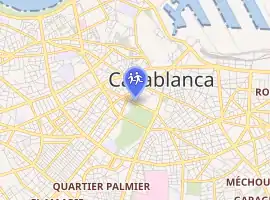School of Fine Arts of Casablanca
The School of Fine Arts of Casablanca (Arabic: المدرسة العليا للفنون الجميلة بالدار البيضاء, French: l'Ecole des Beaux-Arts de Casablanca) is a fine arts school in Casablanca, Morocco.
| School of Fine Arts of Casablanca المدرسة العليا للفنون الجميلة بالدار البيضاء l'Ecole des Beaux-Arts de Casablanca | |
|---|---|
| Location | |

| |
20 boulevard Rachidi, Casablanca | |
| Coordinates | 33.5921°N 7.6233°W |
History
The institution was founded in 1919 by a French Orientalist painter named Édouard Brindeau de Jarny, who started his career teaching drawing at Lycée Lyautey.[1][2] Resident General Hubert Lyautey tasked Brindeau and Prosper Ricard with cataloguing Moroccan visual heritage to inform the guidelines for vocational schools and the reform of traditional industries.[2] Brindeau convinced Resident General Lyautey and Georges Hardy, director of public education under the French Protectorate, to establish a school of fine arts in Casablanca's medina. In the beginning, students learned applied arts for architecture, interior design, decoration, and architectural landscaping, in addition to drawing, painting, art history, and math.[2] The school also hosted ateliers ouverts (open workshops) for European and Moroccan artists and craftsmen, as well as students and instructors from other institutions.[2] Abdeslam Ben Larbi el Fassi, whom Toni Maraini described as "the first Modern Moroccan artist," was one of the school's first students.[2]
The school was overseen by the municipality chief, four members of the municipal council, and the director of Lycée Lyautey.[2] They chose the rules, appointed the director, and required that all instructors held French nationality.[2] A small number of sons of Moroccan notables were admitted, and they were not allowed to participate in any exhibitions without his consent.[2] The school promoted itself by advertising that graduates could become "art instructors, advertising designers, interior decorators, typesetters, and builders of maquettes."[2] In his book Art in the Service of Colonialism, Hamid Irbouh writes that Moroccan students were trained to become "technicians to assist French architects."[2] It pushed Moroccan students toward becoming master craftsmen, studying ceramics, architectural drafting, and interior decoration, while pushing French students toward fine arts and to apply to Écoles des Beaux-Arts in France.[2]
Casablanca School
Farid Belkahia became the director of the School of Fine Arts of Casablanca in 1962.[3][4] From 1964-1972, the Nativist Casablanca School, composed of Belkahia and faculty members Mohammed Melehi and Mohammed Chabâa, worked toward what Belkahia described as a "democratization" of the art curriculum.[2] The curriculum incorporated heavy use of local traditional crafts in their art and worked with their instructors on projects.[2]
In 1969, the Casablanca School held the exposition manifeste in the Jemaa el-Fnaa of Marrakesh, displaying their work in public.[5]
Alumni
Alumni of the School of Fine Arts of Casablanca include:
- Abdelakabir Faradjallah of Attarazat Addahabia
- Ikram Kabbaj[6]
- Meryem Aboulouafa
References
- Marcilhac, Félix; Majorelle, Jacques (1988). La vie et l'œuvre de Jacques Majorelle: 1886-1962 (in French). www.acr-edition.com. ISBN 978-2-86770-031-6.
- Irbouh, Hamid. (2013). Art in the Service of Colonialism : French Art Education in Morocco 1912-1966. I.B. Tauris. ISBN 978-1-78076-036-0. OCLC 994563861.
- "Farid Belkahia, incubateur de modernité". Telquel.ma (in French). Retrieved 2020-07-03.
- "École des Beaux-Arts de Casablanca (1964–1970) - Articles – bauhaus imaginista". www.bauhaus-imaginista.org. Retrieved 2020-07-03.
- Basciano, Oliver (2019-04-12). "Give us a swirl: How Mohamed Melehi became Morocco's modernist master". The Guardian. ISSN 0261-3077. Retrieved 2020-07-03.
- "الفنانة المغربية إكرام القباج تعرض منحوتاتها الجديدة بالدار البيضاء". bayanealyaoume (in Arabic). 2016-09-22. Retrieved 2020-07-03.